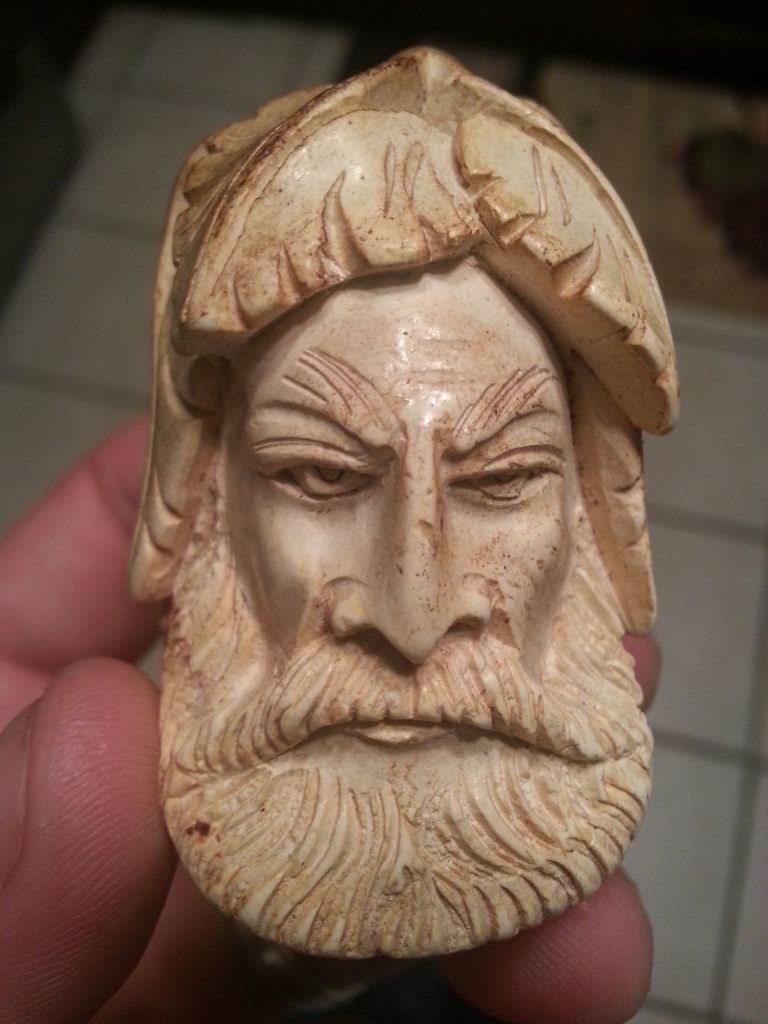New meerschaum pipe
Comments
-
very good pics!!!!!0
-
Wish I could take credit, but they're pics from the pipe's listing0
-
Great looking new addition!! Keep us posted with pictures
 0
0 -
That looks great! You will not be disappointed. It will take some time to see the color change, but keep the pics coming. I love seeing a Meer as it changes and deepens in coloration.0
-
Holly F-ck! where did you get that? That's is freaking awesome! BTW is one suppose to paint that or is it just suppose to be white?0
-
Meers will aways start white (at least the good ones will some can be yellow but normally they are not from blocks mined in Turkey) but they will color as you smoke them. You should never paint one.0
-
No, no no Pheebs - never paint a meer. They color naturally just from smoking them, or from your fingers if you smoke the pipe with dirty hands (not recommended - wash your hands before handling a meerschaum)
Meerschaum is a very porous material, though it can be more porous or less porous depending on its region - there's the cheapest grade of meer - essentially leftover chips that were ground up and glued together, like particle board - this meer will never color and remain forever white (you may wanna paint this one). The higher grade is what's known as block meerschaum - a pipe carved from a single block of meerschaum, and the blocks typically come from one of two regions. African meer is harder and less porous, turkish meer is the most porous and most soft (and these come in different grades as well) - just rubbing a turkish meer on your shirt can literally scratch the pipe, but by being more porous, it colors easier too.
Meers color when the beeswax that they're dipped into (after carving is finished) absorbs the oils and tar from the tobacco; the color works its way outward - the oils and tars don't color the meerschaum, they color the beeswax that runs throughout the porous meerschaum. This will happen over time regardless, but you can hurry the coloring along by rewaxing the pipe periodically, which will draw out the oils and tars to the surface; the effect can be dramatic in old pipes that have been waxed for the first time after years of smoking.
Meer is naturally white, but after it's carved, one of two beeswax are used - natural or bleached. Bleached beeswax is clear and gets you the white pipe that colors over time; natural beeswax is a light brown color, so it'll look like your pipe is partially colored already - this will darken over time as the pipe absorbs the tars and nicotine just like the bleached/white meer will, it just starts out looking different. As for which wax is used, it's personal preference of the carver and what the customer wants
The pipe I have is from Fikri Baki, a turkish carver.
A bit more than you may have wanted to know, but all turkish meerschaum is carved by turkish carvers since Turkey has an export ban on unfinished meerschaum blocks; the oldest and most ornate pipes, though, were carved by the old european masters, long before the ban was put in place.0 -
Very nice. I like that design and if or when I get one it will be similar. I am not into the heads of people they seem to enjoy carving.0
-
Found it - this is a good example of what the old european masters could do with a solid block of meerschaum; they learned from wood and transferred their skills to the new medium of meerschaum when it was discoveredxmacro:A bit more than you may have wanted to know, but all turkish meerschaum is carved by turkish carvers since Turkey has an export ban on unfinished meerschaum blocks; the oldest and most ornate pipes, though, were carved by the old european masters, long before the ban was put in place.
For more pics, and good summary of meerschaums history, try this: http://thenonist.com/index.php/thenonist/permalink/the_meerschaum_pipe/
0 -
I picked up a Meerschaum pipe a couple of weeks ago. I love it! I also have a Peterson Pipe as well.
0 -
I'd love to see continuing pics of the pipe as you use it and the color changesLLA - Lancero Lovers of America0
-
holy crap. that is awesome.xmacro:Hand carved by the master turkish carver, Fikri Baki, bought it to commemorate a milestone in my life (at least that's how I'm justifying it![Stick out tongue [:P]](/cs/emoticons/emotion-4.gif) ). Can't wait to put some bowls into this and watch it color
). Can't wait to put some bowls into this and watch it color


 0
0 -











